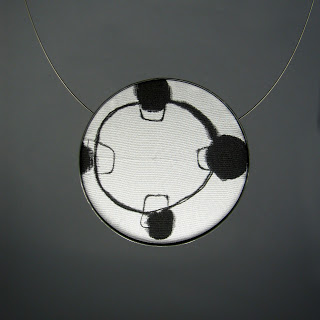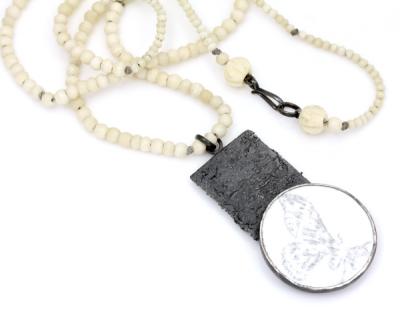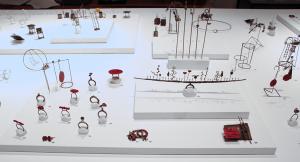There seem to be three elements that contribute to your exhibition. Can you describe the role of silk, of cast metal, and of the story that goes with it?
Maya Kini: This show developed out of my thesis work at Cranbrook and a series of objects my Indian grandmother carried with her in her purse. There were mundane objects—dentures, bobby pins, and handkerchiefs—and also ornate gold jewelry. Essentially, she had all of the jewelry she owned in her purse at the time of her death. I imagined what an archaeologist might do with such an archive, and so I studied it, cataloged it, and eventually wrote a series of short stories based on these objects. I then attempted to develop a language based on these cataloged objects to make jewelry. While the resulting pieces were largely unsuccessful, that was the first time I cast silk, and I fell in love with the texture and the process of casting. I decided then to focus on the silk and its translation into metal. In that process, I discovered the palette, textures, and forms that I had been looking for.
How did the idea for this show develop?
Maya Kini: We visited India in 2009–my first visit there as an adult. We went to a government silk factory where the workers take the silk through the entire process, from boiling the cocoons to spinning the thread, dying the thread, weaving the silks, and embellishing them with the zari (metallic thread). While on that trip, my aunt gave me a pile of saris woven in the Indian city of Benares in the 1960s. The saris were made of silk georgette with silver embroidery. They had belonged to my grandmother, but the silk was now so fragile that they could not be worn without tearing.
The saris sat in my studio until I had the idea to cut out small sections with the silver embroidery, back them with wax, and take them through the lost-wax process. The resulting pieces often emerged looking more moth-eaten than when they had gone into the molds. But, I found that the silver woven into the original sari material did not burn out in the mold. Instead, it became embedded into the casting. This was a lovely discovery, for it meant that there was part of the original cloth in the new casting. It fell in line with how I think about the process of casting in general, which is a way to generate something imperfectly related to the original rather than a perfect copy.
The sculptor Rachel Whiteread (who uses casting to illuminate the space between things, or the space we don’t often consider) says this of the process of casting:
A cast of an object traps it in time, eventually displaying two histories–its own past and the past of the object it replicates. The perfect expression of this is the death mask. It captures all the physical accretions of the human face soon after that face has completed its living existence but before rigor mortis accelerates it towards disintegration. It remains in the world to remind us of the dead as both portrait and memorial, a replica of an object in its own right.
For me, the silk is material—strong, soft, and lavish. The metal is a neutral space where the texture and embellishments on the silk can come alive and be preserved, and the story relates these materials back to the people they will outlive.























